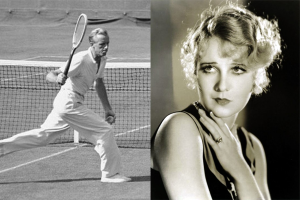Los Angeles and Hollywood is in full Oscar mode as the annual Academy Awards will honor the best in motion pictures this Sunday night. In 1944, 1945, and 1946, the Academy Awards ceremonies were held at the famed Grauman Chinese Theatre, which is now the site of the Hollywood Walk of Fame. While tennis has not been a subject of many motion pictures (although the soon-to-be-released TITANIC: THE TENNIS STORY would make a phenomenal film), a Wimbledon champion actually had his hand print and signature among the Hollywood elite – albeit only for a short period of time. In his book THE WIMBLEDON FINAL THAT NEVER WAS…AND OTHER TENNIS TALES FROM A BYGONE ERA ($14.95, New Chapter Press, www.NewChapterMedia.com, available here in hard and electronic versions on BarnesandNoble.com: http://www.barnesandnoble.com/
***
Tournament tennis competitors are no strangers to the roller coaster rise and fall of fortune, from the high excitement of victory to the near-inconsolable depths of defeat. But an experience that crossed my path at age 17 was a useful early lesson in just how rapidly a burgeoning pouter pigeon ego can suffer overnight deflation. It occurred, of all places, at Grauman’s Chinese Theatre in Hollywood, where practically all the big movie “first nights” were then staged.

At the grand opening of the world’s very first talkie-musical Broadway Melody starring Joan Crawford and Eddie Cantor, I had the excruciating honor of serving as squire to the show’s featured starlet, Miss Anita Page, whose dazzling blonde beauty graced the covers of myriad movie magazines. Anita was also 17 and a real live Wampus Baby Star (Hollywood’s then equivalent of a junior Davis Cup squadder).
Looking back at what seems like another age, I remember the blinding Klieg lights, hordes of screaming idolaters and everyone darting around like so many hummingbirds among a surfeit of nectared flowers. Alighting from our MGM limousine, with the unattainable queen of my dreams at my side, I was intoxicatingly out of touch with reality. Anita, who must have been rehearsed for this amazing plunge into hysteria, would not let us be severed, as cameras flashed and microphones were stacked before her.
As we slowly advanced up the canopied entrance walk, Anita, swain on arm, was ushered across the theatre’s plaza to the roped off, hallowed sanctum where footprints of the heroes and heroines of the silver screen were cast in concrete cemented relief. A tuxedoed gentleman helped Anita off with a shoe and stocking, but, sweetly thoughtful girl that she was, she insisted that my foot too be encased side by side with her own dainty imprint for all posterity. The movie was interrupted from time to time by waves of applause, as the performers first appeared on screen, and I was aglow with a vicarious thrill as Anita’s resounding ovation enveloped us.
The next morning’s papers were devoured for pictures, but they had cropped off all but your unfamous hero’s elbow. Never mind. Fairly early, I summoned my cohort of tennis pals to foregather at Grauman’s to view friend Sidney’s claim to enduring fame. What a shocker! Overnight, a heartless mason, perhaps anticipating Hollywood’s future real estate escalation, had troweled over my immortal sole, leaving Anita’s delicate alfresco arch without its protector. Why, oh why, couldn’t they have waited just one more day?
Some years later, Anita who had retired from pictures to marry a Navy Captain and become a San Diego housewife, read in the local sports page that I was playing in the Pacific Southwest tournament in Los Angeles, and she drove up to say hello and watch some tennis. Because I seated the coruscant Anita in a front row box, few of the stadium spectators’ eyes were focused on the match in progress.
